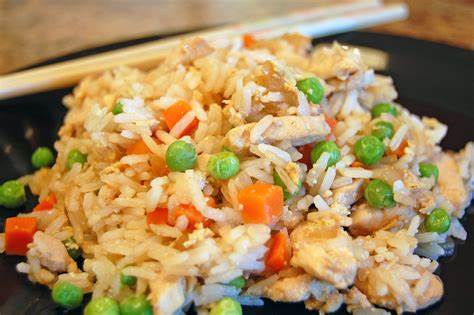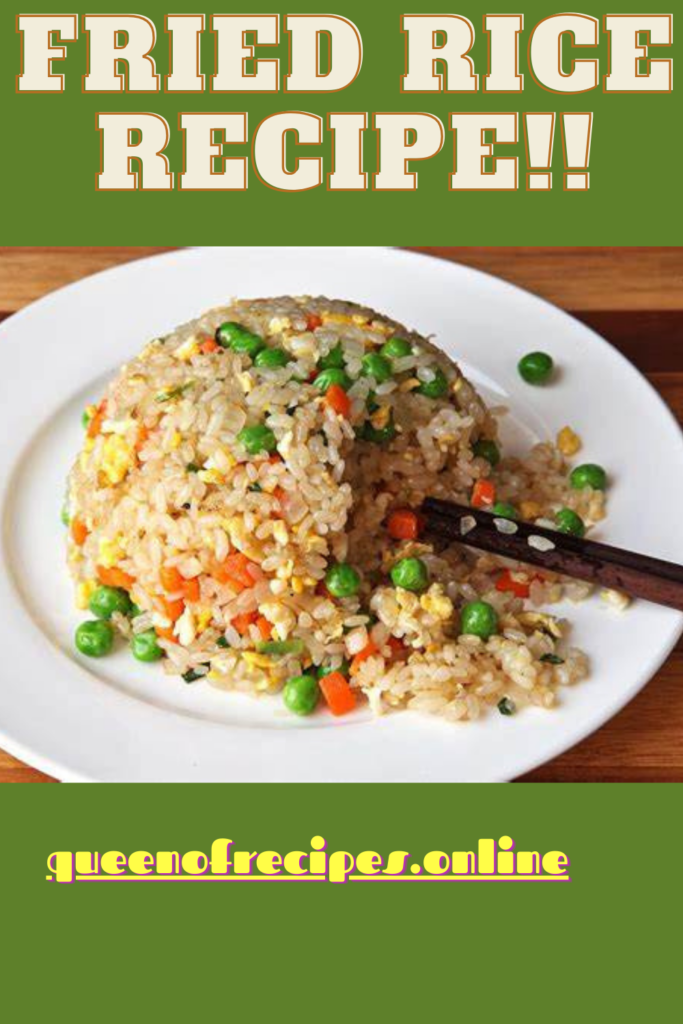About for Fried Rice
Fried rice is a popular dish in Asian cuisine that is made by stir-frying cooked rice with a variety of vegetables, and seasonings. The dish is known for its simple preparation, versatility, and flavorful taste. The basic ingredients of fried rice include cooked rice, vegetables such as onions, carrots, peas, and capsicum, and protein such as tofu.
The dish is usually seasoned with soy sauce, vinegar, and other spices like ginger, garlic, and black pepper. The rice is stir-fried in a wok or large skillet over high heat, allowing it to cook quickly and become slightly crispy. The vegetables and protein are added to the wok and cooked until they are slightly tender but still retain their crunch. The seasoned rice is then added to the wok and tossed with the vegetables and protein until everything is evenly coated with the seasoning. Fried rice is often served as a side dish or as a main course with additional side dishes such as spring rolls, steamed vegetables, or soup.
Ingredients:
- 2 cups cooked long-grain rice, cooled and refrigerated for a few hours or overnight
- 2 tbsp oil
- 3-4 garlic cloves, minced
- 1 small onion, chopped
- 1 cup mixed vegetables (such as carrot, capsicum, cabbage, peas, etc.), chopped
- 2-3 green chilies, chopped
- 1 tbsp soy sauce
- 1 tsp vinegar
- 1 tsp sugar
- Salt to taste
- A pinch of black pepper powder
- A handful of chopped spring onion greens
Instructions:
- Heat oil in a wok or large pan over high heat.
- Add minced garlic and saute for a few seconds until fragrant.
- Add chopped onions and saute for 1-2 minutes until translucent.
- Add chopped mixed vegetables and green chilies. Saute for 2-3 minutes until the vegetables are slightly cooked but still crunchy.
- Add soy sauce, vinegar, sugar, salt, and black pepper powder. Mix well to combine.
- Add the cooked and cooled rice to the pan. Toss well to combine with the vegetables and the sauce. Cook for 2-3 minutes until the rice is heated through and well coated with the sauce.
- Switch off the flame and garnish with chopped spring onion greens.
Your homemade fried rice is ready to serve! Serve hot as a side dish or with your favorite Chinese-style main dish.


Nutritional value
The nutritional value of fried rice can vary depending on the ingredients used and the serving size. Here is an estimate of the nutritional value of a typical serving (1 cup) of fried rice made with long-grain white rice and mixed vegetables:
- Calories: 250-350
- Protein: 5-10 grams
- Fat: 7-10 grams
- Carbohydrates: 40-50 grams
- Fiber: 2-4 grams
- Sodium: 600-900 milligrams
- Vitamins and minerals: Vitamin A, Vitamin C, iron, calcium
Keep in mind that the actual nutritional value of fried rice can be higher if it contains additional ingredients such as meat, eggs, or nuts, which can add more protein, fat, and calories. Similarly, if the fried rice is made with brown rice instead of white rice, it can provide more fiber, vitamins, and minerals. Additionally, the portion size of fried rice can vary depending on the recipe, so it’s important to be mindful of your serving size to avoid consuming too many calories or sodium.
In conclusion, fried rice is a versatile and delicious dish that can be enjoyed by people all around the world. With its origins in Asia, fried rice has become a popular dish in many cultures and can be customized to suit different tastes and dietary needs. Whether you prefer it spicy or mild, vegetarian or with meat, there is a fried rice recipe out there that will satisfy your cravings. By following the tips and techniques outlined in this blog, you can create your own flavorful and nutritious fried rice dishes at home. So why not give it a try and discover your new favorite recipe?
Health Benefits
Fried rice, while delicious, is typically a dish that is higher in calories and fats due to the frying process. However, it can still offer some nutritional benefits, depending on the ingredients and preparation methods used. Here are some potential health benefits of fried rice:
- Source of Carbohydrates: Fried rice is primarily made with cooked rice, which is a good source of carbohydrates. Carbohydrates provide the body with energy for various daily activities.
- Protein Content: If fried rice includes ingredients like chicken, shrimp, tofu, or eggs, it can be a source of protein. Protein is essential for tissue repair, muscle building, and overall body functions.
- Vegetable Nutrients: If fried rice contains a variety of vegetables like carrots, peas, bell peppers, and broccoli, it can offer vitamins, minerals, and dietary fiber. Vegetables provide essential nutrients and support digestive health.
- Satiety: The combination of carbohydrates and protein in fried rice can help keep you feeling full and satisfied after a meal.
Despite these potential benefits, it’s essential to be mindful of the cooking method and ingredients to maximize the nutritional value of fried rice:
- Limit Added Fats: Fried rice is often prepared using oil or butter for frying. Using a moderate amount of heart-healthy oils like olive or sesame oil can help reduce saturated fat content.
- Portion Control: Be mindful of portion sizes, as fried rice can be calorie-dense. Stick to appropriate serving sizes to avoid overeating.
- Sodium Content: Be cautious with the use of soy sauce or other condiments, as they can be high in sodium. Consider using reduced-sodium options or using them sparingly.
- Balanced Ingredients: Opt for a balanced mix of vegetables, protein, and whole grains to increase the nutritional value of the dish.
- Consider Alternatives: For a healthier option, you can try making fried rice with brown rice or cauliflower rice, which provides more fiber and nutrients.
- Homemade Preparation: Preparing fried rice at home allows you to control the ingredients and cooking methods, making it easier to create a healthier version.
Overall, while fried rice can offer some nutritional benefits, it is essential to enjoy it in moderation and choose healthier cooking methods and ingredients to make it a more nutritious part of your diet.
Tips and Tricks
Here are some tips and tricks to make delicious and flavorful fried rice:
- Use Cold Cooked Rice: Fried rice turns out best when made with cold, day-old rice. Freshly cooked rice tends to be sticky, while cold rice separates easily, giving your fried rice a better texture.
- Prep Ingredients in Advance: Have all your ingredients chopped and ready to go before you start cooking. This ensures a quick and seamless cooking process.
- High Heat Cooking: Use a wok or a large skillet and cook the fried rice over high heat. High heat helps achieve the characteristic smoky flavor and prevents the rice from becoming mushy.
- Oil and Aromatics: Start by heating some oil (sesame or vegetable oil) in the wok and sautéing chopped garlic, ginger, and chopped onions until fragrant. These aromatics add depth to the dish.
- Choice of Vegetables: You can use a variety of vegetables like carrots, peas, bell peppers, broccoli, and green beans. To ensure even cooking, consider blanching harder vegetables like carrots and broccoli before adding them to the wok.
- Protein Options: Feel free to add protein of your choice, such as diced chicken, shrimp, tofu, or eggs. If using eggs, scramble them separately and then mix them into the fried rice.
- Soy Sauce and Seasonings: Use low-sodium soy sauce to avoid excessive saltiness. You can also add a splash of oyster sauce or fish sauce for extra umami flavor. Add a pinch of white pepper for some heat.
- Don’t Overload: Avoid adding too many ingredients, as it can make the fried rice heavy and difficult to cook evenly.
- Stir-Fry Technique: Use a gentle yet constant tossing motion to combine all the ingredients and distribute the flavors evenly.
- Garnish: Finish the fried rice with a drizzle of toasted sesame oil and garnish with chopped green onions or cilantro for added freshness.
- Experiment with Seasonings: Feel free to experiment with different seasonings, such as chili flakes, garlic powder, or even a dash of curry powder, to create unique flavor profiles.
- Customize to Your Taste: Fried rice is versatile, so you can adjust the ingredients and seasonings to suit your preferences and dietary needs.
Remember, fried rice is a flexible and forgiving dish, so don’t be afraid to get creative and make it your own! Enjoy your homemade fried rice as a delicious and satisfying meal.


Serving Suggestions
Fried rice is a versatile dish that can be customized with a variety of ingredients. Here are some serving suggestions to elevate your fried rice experience:
- Soy Sauce and Chili Oil: Serve the fried rice with additional soy sauce and chili oil on the side, allowing diners to adjust the flavor according to their preference.
- Scallions: Garnish the fried rice with thinly sliced scallions (green onions) for a fresh and aromatic touch.
- Sesame Seeds: Sprinkle toasted sesame seeds over the fried rice for a nutty and crunchy texture.
- Lime Wedges: Offer lime wedges on the side for a burst of tangy citrus flavor that complements the savory rice.
- Crispy Shallots or Garlic: Fry thinly sliced shallots or garlic until crispy and use them as a crispy topping for the fried rice.
- Chopped Cilantro: A handful of chopped cilantro adds a vibrant color and a fresh, herbaceous flavor to the dish.
- Peanuts or Cashews: Add chopped toasted peanuts or cashews for a delightful crunch and nutty taste.
- Chopped Vegetables: Serve the fried rice with a side of fresh chopped vegetables like cucumbers, bell peppers, and tomatoes for a refreshing contrast.
- Sriracha or Hot Sauce: Place bottles of Sriracha, hot sauce, or chili paste on the table for those who prefer an extra kick of heat.
- Fried Tofu or Tofu Cubes: If you’re making vegetarian or vegan fried rice, consider adding fried tofu or tofu cubes for added protein and texture.
- Pineapple Chunks: For a tropical twist, serve the fried rice with chunks of fresh pineapple, which adds a sweet and tangy flavor.
- Pickled Vegetables: Offer pickled vegetables like kimchi or pickled radishes on the side to provide a tangy and flavorful contrast.
- Steamed Edamame: A side of steamed edamame adds a nutritious and protein-packed element to the meal.
- Cucumber Raita: A cooling cucumber raita can be served alongside the fried rice to balance out the flavors.
Feel free to mix and match these suggestions based on your preferences and the type of fried rice you’re serving, whether it’s vegetable fried rice. The goal is to create a well-rounded and satisfying meal that offers a variety of tastes and textures.
FAQs
Can I use freshly cooked rice for fried rice?
While using cold, day-old rice is recommended for better texture, you can still use freshly cooked rice. Spread it out on a baking sheet and let it cool down to room temperature before using it for fried rice.
Can I make fried rice with different cuisines?
Yes, fried rice is versatile and can be adapted to various cuisines. For example, you can make Chinese-style fried rice, Thai pineapple fried rice, or Indian vegetable biryani-style fried rice.
How do I add flavor to fried rice without soy sauce?
You can use alternative seasonings like tamari (gluten-free soy sauce), coconut aminos, or a mixture of hoisin sauce and rice vinegar for added flavor.
Can I use any type of rice for fried rice?
While long-grain rice like jasmine or basmati is commonly used for fried rice, you can also use short-grain rice or brown rice for added nutritional benefits.

